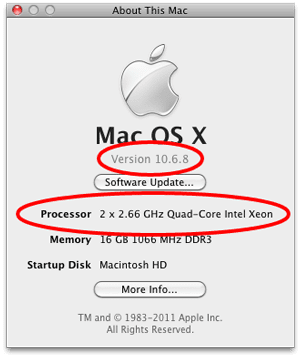 OS X 10.8 Mountain Lion is on its way, and we’re all looking forward to all the new features and tweaks that this latest version offers. Unfortunately, not every Mac user is going to be able to ugrade to Mountain Lion, though. While Macs generally have a long “active support” life, every iteration of OS X leaves a generation or two behind and Mountain Lion is no exception.
OS X 10.8 Mountain Lion is on its way, and we’re all looking forward to all the new features and tweaks that this latest version offers. Unfortunately, not every Mac user is going to be able to ugrade to Mountain Lion, though. While Macs generally have a long “active support” life, every iteration of OS X leaves a generation or two behind and Mountain Lion is no exception.
The big thing this time around is 64-bit compatibility. Your computer needs to not only have a 64-bit capable processor, but also 64-bit capable EFI boot firmware. Some Macs, like the 2006 and 2007 Mac Pros, have 64-bit processors, but their EFI firmware is only 32-bit capable, so they won’t be able to run Mountain Lion.
According to Apple, the following computers will be able to run 10.8 Mountain Lion. If you don’t know how to find your Model ID, we’ve got a guide that will show you where to look.
- iMac (Mid 2007 or newer)
ModelID: iMac7,1 or later - MacBook (Late 2008 Aluminum, or Early 2009 or newer)
ModelID: MacBook5,1 or later - MacBook Pro (Mid/Late 2007 or newer)
ModelID: MacBookPro3,1 or later - MacBook Air (Late 2008 or newer)
ModelID: MacBookAir2,1 or later - Mac mini (Early 2009 or newer)
ModelID: Macmini3,1 or later - Mac Pro (Early 2008 or newer)
ModelID: MacPro3,1 or later - Xserve (Early 2009)
ModelID: Xserve3,1
If your machine makes the cut, you’re only part way there. There are a number of other specifications you’ll want to make sure you meet before installing:
- Apple requires at least 8GB of free space on your main drive. However, that doesn’t include space required for any applications or extra documents. If your drive is relatively full already, you may want to go ahead and either purchase a larger platter-based drive or add an OWC SSD with an OWC Data Doubler to accommodate the new files. If you go with the latter, you may wish to look into our guide for splitting the OS and User Files between the two for best compatibility; though it was originally written with Lion in mind, it should also work for Mountain Lion.
- Apple also requires at least 2GB of memory for running the OS. Once you start running multiple applications at once, you’ll notice a drop in performance. We recommend installing at least 4GB, preferably 8GB, and ideally the maximum amount your computer can handle. Don’t limit yourself to Apple’s suggested maximums, though; many Macs can handle much more memory than Apple lets on. To find out if your computer is one of these, check out our MaxRAM certification page.
- Since Mountain Lion is only downloadable from the Mac App Store, you will need to have either Snow Leopard 10.6.8 or Lion 10.7.x installed prior to upgrading, so that you can access it.
- Since it is only downloadable, you will also need a fairly quick Internet connection.
All indications are that Mountain Lion will be arriving within the next week or two, so make sure you’re ready today!








Hi Chris,
I own a 20″ Early 2007 Imac (model ID: 7,1). I would like to replace my DVD drive with an SSD drive (using the OWC Data Doubler). Howerer, it seems that the OWC Data Doubler is only compatible with Early 2009 & Mid 2009 Imacs (ID: 9,1) and later models. I’ve been searching in the web, but I can’t find information on how to install a second drive in my 2007 Imac model. Any help or info about this would be very much appreciatted! Thanks in advance!
The iMac7,1 optical drive is an IDE/ATA connection. The OWC Data Doubler solution only works with optical drive bays that have SATA connections, which are found in the iMac9,1 and later.
Thanks for your reply, Chris! I guess that makes the OWC Data Doubler not suitable for my computer.
Any solution available at OWC with an IDE/ATA connection to replace the DVD drive for a SSD drive?
We unfortunately do not have any solution to replace an optical drive with a Hard Drive or Solid State Drive for iMacs earlier than the iMac9,1. You may replace the primary drive with a Solid State Drive when using a 2.5″ to 3.5″ drive like our Newer Technology AdaptaDrive.
Rosetta is a must. I am on Mac OS X 10.6.8, I have NOT upgraded to Mac OS X 10.7 and I will NOT upgrade to Mac OS X 10.8 because I have found no replacement so far for:
– Eudora (e-mail).
– Palm Desktop (PDA-PIM)
– Canvas (drawing)
That is a deal-breaker for me!
Lack of Rosetta support is one of the most-cited reasons for not upgrading to Lion or later. As long as your needs are being met by 10.6.8 and the software that runs on it, there is absolutely no reason you should upgrade.
However, you do need to keep in mind that, eventually, you may be forced to upgrade, whether it’s because you’ve purchased a new Mac that can’t run 10.6 or because other software or accessories require 10.7 or later for compatibility. Then, there’s also security issues to think of, as well; once 10.9 eventually comes out, 10.6 will no longer be supported security-wise.
So it’s probably not a bad idea to start thinking of alternatives and preparing for a changeover.
Eudora – It’s funny… on nearly every list I see of programs people are upset that they’ll lose, Eudora is one of them. It’s got a following, to be sure, even though it hasn’t been updated in several years. I tried it once, after Claris Emailer got scrapped, but it just wasn’t for me. Different strokes for different folks, I guess. But this isn’t the place for Email client preference debates.
All is not lost for you Eudora fans; it seems a team of Eudora engineers from Qualcomm are working on an Open Source Edition of Eudora, based on the Mozilla Thunderbird framework. You may want to check it out.
Palm Desktop – Yeah, I can see how losing this one can be a bit of a downer; I’ve been rocking a PalmOS-based phone since my Kyocera 6035 in 2001, so losing the ability to sync was unacceptable. However, when PalmOS got superseded by webOS, I figured my next phone would be an iPhone. As such, I started syncing to the Apple organizational suite (iCal, AddressBook, etc.) using The Missing Sync by Mark/Space about 3 years ago, and haven’t had any troubles with it. This may be an option for you.
Canvas – This is the only one I really don’t have any specific suggestions for, mostly because I never really used it; as far as I can tell, it’s like a combination of a vector and raster-based imaging program. The last program like that I used was Aldus SuperPaint in the early 90’s.
About the only advice I could give would be to start moving your old files to a more “standard” format, such as svg or TIFF (as appropriate), and look into applications appropriate to the type of work you do with it. If you’re going to go the freeware route, I’ve heard great things about Inkscape, GIMP, and Scribus for vector imaging, raster imaging, and page layout, respectively. Sure, they’re no Adobe Creative Suite and there will be some learning curve, but they’re also considerably cheaper, so if you don’t like them, you can get rid of them without having wasted any money.
The point is that while lack of support for older software is a pain, you can only stay at a certain software level for a relatively short while before being left behind completely. It’s best to start making plans now, so you’re ready for when “the time” comes.
DISCLAIMER: OWC has no affiliation with any software packages listed above and receives no benefit related to this support (other than a benefit we all share in the continued support of these applications). If you appreciate the function or functionality this software offers, we encourage you to support the authors.
Hi Chris, I’m happy to read that there’s a way to continue syncing a Palm with the Mac on OS 10.8 with the Missing Sync workaround. Can you clarify – do I get the Missing Sync installed, and after that my Palm Centro will just seamlessly sync with the Apple organizational suite (iCal, AddressBook, etc.)? And also reverse, i.e. info added on the computer will be synced to the Centro? There must be some functions that Palm Desktop has that are different or missing in the Apple organizational suite and that would get lost? Thanks so much.
I didn’t really ever use the Palm suite itself (I used the conduits for the Apple apps for a while before I switched to Missing Sync), so I can’t really speak to the differences there. I found all the things I used frequently (calendar, contacts, backup) were covered sufficiently for my purposes.
Apple changed a couple of things up with 10.8, such that you do have to perform a couple additional steps in order to sync your calendars using Missing Sync. There should be information on the Mark|Space Web site that tells you how to do this.